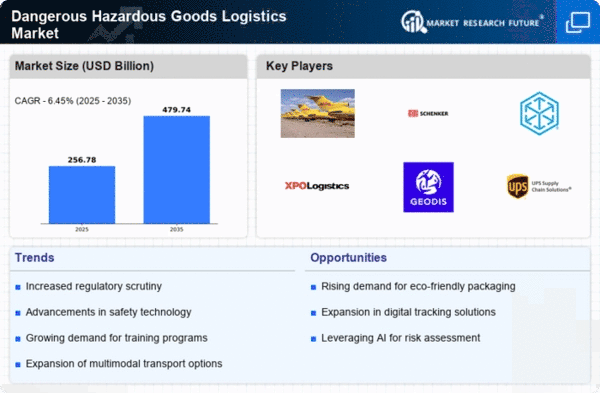The Dangerous Hazardous Goods Logistics Market is characterized by a complex interplay of regulatory compliance, technological advancements, and evolving customer demands. Key growth drivers include the increasing globalization of trade, stringent safety regulations, and the rising need for specialized logistics solutions. Major players such as DHL Supply Chain (DE), Kuehne + Nagel (CH), and DB Schenker (DE) are strategically positioned to leverage these dynamics. DHL Supply Chain (DE) focuses on innovation through digital transformation, enhancing operational efficiency and safety protocols. Kuehne + Nagel (CH) emphasizes sustainability, integrating eco-friendly practices into its logistics operations, while DB Schenker (DE) is expanding its global footprint through strategic partnerships and acquisitions, thereby enhancing its service offerings.
The market structure appears moderately fragmented, with a mix of large multinational corporations and regional players. Key business tactics include localizing manufacturing to reduce lead times and optimizing supply chains to enhance responsiveness. The collective influence of these major players shapes competitive dynamics, as they strive to differentiate themselves through specialized services and technological advancements.
In November 2025, DHL Supply Chain (DE) announced a partnership with a leading technology firm to develop an AI-driven platform aimed at improving hazardous materials tracking and compliance. This strategic move is likely to enhance operational transparency and safety, positioning DHL as a leader in innovative logistics solutions. The integration of AI technology could streamline processes, reduce human error, and ensure adherence to stringent regulations, thereby reinforcing customer trust.
In October 2025, Kuehne + Nagel (CH) launched a new initiative focused on carbon-neutral logistics for hazardous goods. This initiative aligns with global sustainability goals and reflects the company's commitment to reducing its environmental footprint. By offering carbon-neutral options, Kuehne + Nagel not only meets regulatory demands but also appeals to environmentally conscious clients, potentially increasing its market share in a competitive landscape.
In September 2025, DB Schenker (DE) completed the acquisition of a regional logistics provider specializing in hazardous materials. This acquisition is expected to enhance DB Schenker's capabilities in the hazardous goods sector, allowing for improved service delivery and expanded geographic reach. The strategic importance of this move lies in the ability to offer more comprehensive solutions to clients, thereby strengthening its competitive position in the market.
As of December 2025, current trends in the Dangerous Hazardous Goods Logistics Market indicate a strong emphasis on digitalization, sustainability, and AI integration. Strategic alliances are increasingly shaping the competitive landscape, as companies seek to enhance their service offerings and operational efficiencies. The shift from price-based competition to a focus on innovation, technology, and supply chain reliability is evident, suggesting that future competitive differentiation will hinge on the ability to adapt to these evolving trends.

















Leave a Comment